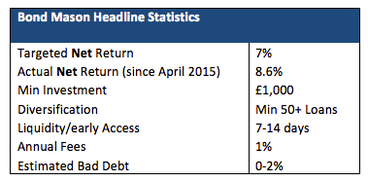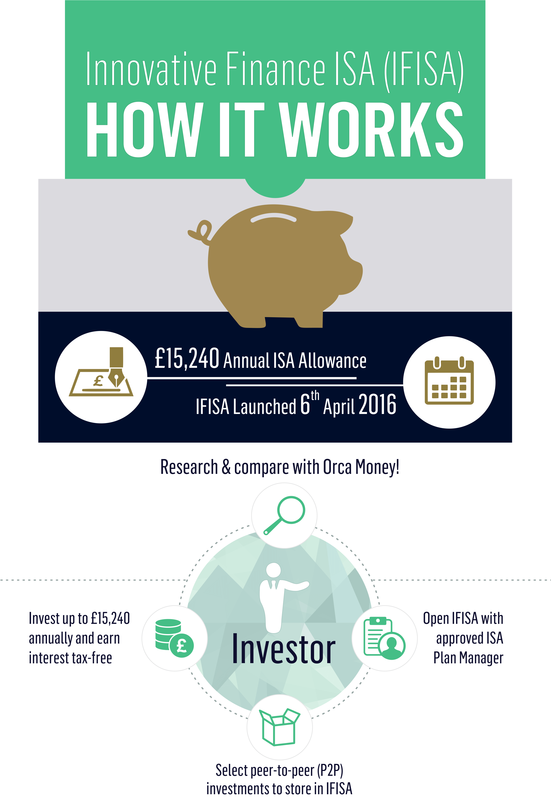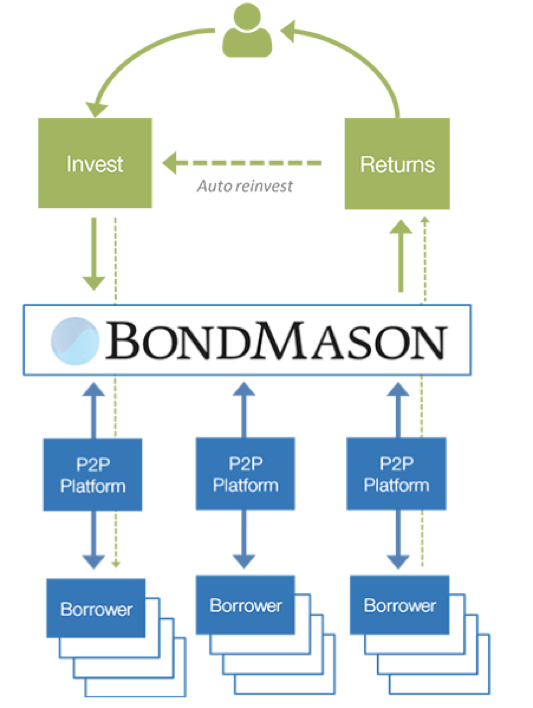
 We are pleased to announce our upcoming event to take place at StartPlanet NI, 112-114 Donegall Street, Belfast BT1 2GX, Northern Ireland on Tuesday 27th September kicking off at 600pm (registration from 530pm) to 800pm. We will be discussing Northern Ireland’s Fintech Scene and its Challenges and Opportunities Post Brexit and shinning a bright light on Northern Ireland’s burgeoning fintech industry and the innovators helping to drive Northern Ireland’s continuing success.
0 Comments
 Thanks to Orca Money for sharing these useful graphics on Marketplace Lending (Risk v Mitigation) and Innovative Finance ISA. The graphics are below, however you might find the quality of these graphics better on Orca Money's website at:
P2P asset managers to enter the market: Iain Niblock, CEO of Orca Money looks at one offering22/5/2016  The UK Peer-to-Peer Lending (P2P) market is maturing with a number of new investment instruments on the market offering different methods of investing in P2P. BondMason is one of the first P2P asset managers to enter the market. They actively select P2P investments, building portfolios and allowing retail investors to ‘effortlessly earn 7.0% p.a’. Asset Management seems a logical progression for the P2P market, so here is a deeper look into the BondMason investment offering. Bond Mason Review: Key Investor Statistics BondMason is offering retail and institutional investors access to the P2P market through a managed portfolio.  Figure 1 (above): BondMason Review BondMason’s targeted return of 7% appears appealing, particularly since they are outperforming their targets with a past performance of 8.6%, since April 2015. Although BondMason favour asset-backed P2P investments they do invest across a mixture of borrower types, including: consumer, business and property. How does investing in BondMason work? Simply put, after depositing funds into a BondMason account the investor must entrust the BondMason management team to invest their funds across a number of P2P investment opportunities. The diagram below provides an overview of how BondMason operate: Figure 2 (above): BondMason - How it works?
It is important to note that the underlying assets are the same whether investing directly through a P2P platform or through BondMason. It is the loan selection process which differs. Benefits of investing through BondMason Due Diligence: If conducting investment due diligence is daunting, investors would be advised to employ professionals. Stephen Findlay, CEO of Bond Mason, commented that they undertake a strict due diligence process. ‘We approve 1 out of 3 platforms and 1 out of 3 loan opportunities within the P2P platform. Investor funds are diversified across a minimum of 50 loans.’ 7% Targeted Returns: BondMason targets a reasonable 7% net return. This is net of a 1% annual fee and a 0-2% bad debt estimate. Double Diversification: Investors in P2P are commonly recommended to diversify across a number of loans within a platform, however, it is less commonly highlighted that investing across a number of peer-to-peer lending platforms also adds to diversification. By investing through BondMason investors are able to diversify their funds across a number of P2P platforms and across a number of loans within the P2P platforms. This is called double diversification. Reduced Cash Drag: Cash drag is a consideration that is often overlooked when investing in P2P. Cash drag is created when funds sit in an investor’s account earning no interest, waiting to be lent out. This generally happens when there is too much investor capital on a P2P platform for the level of borrowers on the platform. This is a common occurrence on platforms such as Zopa, particularly around the end of the tax year when more investors come onto the platform wanting to invest. BondMason reduces the effects of cash drag by investing their own capital in loans prior to these loans being made available on the BondMason platform. What are the risks? In addition to the common risks associated with investing in P2P there is one principal risk associated with investing through BondMason that should be considered. When referring to the peer-to-peer lending industry as a whole, Cormac Leech, a P2P analyst at Liberum Investment Bank recently stated: “Fraud risk is the biggest issue because you basically have to trust the management that they're doing what they say they are" The same is true for investing in BondMason. The principal risk is that the BondMason team make bad investment decisions. For investors it is therefore important that they have faith in Stephen Findlay and the BondMason team to invest funds as they say they will. This leads to questions around the composition of the BondMason team. On the BondMason website it states that Stephen Findlay and his seven-person team have over 50 years' combined investing experience. Taking a further look into the CV of Stephen, he has gained an impressive career as both an entrepreneur and Wealth Manager, notably holding key positions at Fidelity. Possibly not a risk, but more of an annoyance, is that investors are unable to see the underlying loans or P2P platforms which BondMason invests in prior to depositing the min deposit of £1000. For some investors it would be comforting to see the logos of some of the top platforms which BondMason are dealing with before depositing the £1000. Conclusion Asset Management is a logical step for the peer-to-peer lending market and the BondMason proposition appears to be a good one. Targeting above market rates whilst offering investor diversification may be a good option for retail investors. Ultimately, the investor will need to trust that the BondMason team can select loans that deliver the promised 7% targeted return.  Spoiler alert, if you were hoping for an announcement of an Irish ‘sandbox’ to join the UK FCA and the Aussie ASIC sandboxes in yesterday's (05 May 2016) fintech speech by the Central Bank, you’ll be disappointed. The word ‘sandbox’ is like the word ‘sex’; if you put it in the heading of a fintech article, you're sure to get attention. There is no indication that the Irish Central Bank is thinking of a sandbox or an innovation hub from today’s speech by Bernard Sheridan (Central Bank Director of Consumer Protection). However nothing in the speech reads to me that the Central Bank will not go down that path. The tone of the speech is very open and cautious, leaving the Central Bank room to manoeuvre (or pivot as we say in industry) as it responds to the challenges of fintech and, in the case of this speech, consumer protection risk. We might expect a prudential driven fintech speech in the future as the areas of financial stability and market conduct area the focal point of other Directors at the Central Bank. At a speech given at the Financial Services Innovation Centre in the Cork yesterday, the senior central banker commenced by saying he ‘was struck by the growing and significant level of interest there is in fintech developments across a wide variety of sources including international regulatory bodies’ and it being ‘a clear sign of things to come’ for regulated and non-regulated fintech firms. Reference was made to a number of Mr Sheridan’s international peers, including;
Returning to Ireland, the regulator noted that its strategic plan has identified the increased risks arising from technological developments and the increased reliance on information technology by regulated firms, their customers and suppliers. He also reminded that cyber risk is a key emerging threat and that the regulator’s Consumer Protection Outlook Report highlighted financial innovations as a key consumer risk - “[t]he consumer benefits of accessibility and convenience must be matched by service reliability, safety and security, and transparency of cost of services”. While I agree that the issue of financial stability risk arising through innovative financial services is important, this isn’t something new. Rather it seems to me that regulators, even if they considered this to be an issue previously, may not have had the confidence to express their concerns until recently. It feels like regulators have been driven out of their comfort zone and forced to confront the rapid (re)evolution in industries which they traditionally pondered about for years, if not decades, before setting out their prudential, consumer and conduct risk concerns. While it is a fair observation to note that “Fintech is transcending traditional boundaries and borders, not just physical but also regulatory as it blurs the lines between regulated and unregulated activities”, this is nothing new. The same can be said of banking and investment house conglomerates which run empires of regulated and unregulated firms, to which the same tests are applicable as to whether they are regulated or not. A significant problem in the world of fintech are the inconsistent interpretations across the EU. For example, peer-to-peer lending is considered to fall under the Payment Services Directive in Germany and Italy, but the same activity in Ireland is not. This has nothing to do with the fact that the activity is provided through fintech or not. The regulator goes on to note that “As new technologies change the everyday provision and delivery of financial services for consumers and firms, it becomes more challenging for regulators to monitor what is going on as the regulatory rulebooks and supervisory tools struggle to keep pace with developments.” Quite frankly, I don’t understand why it becomes more challenging for regulators unless they remain static and continue with outdated and backward looking supervisory systems instead of real-time and data analytic supervisory systems. The information which they need to keep abreast of is rapidly moving to digital format. They have a number of options here: (1) insist on being provided access to this data direct, which is what fintech firm Uphold Inc voluntarily does, by providing real time transaction data to the regulators; (2) ramp up their own resources, i.e. technology, understanding of data analytics, AI, staff and education; and (3) try to stop the advancement so that it remains at a level at which regulators are capable of supervising - but good luck with regulating the internet! Consumer protection and the Central Bank As we know, the Central Bank has a statutory objective of effective regulation of financial service providers and markets, while ensuring that the best interests of consumers are protected. And it is fair for the regulator to let us know its thinking that the disruptive impact of financial innovation is impacting on its risk priorities and the way it does its work. The regulator noted that “[f]intech certainly has the potential to bring many benefits for firms and consumers and the framework should protect the consumer’s best interest and enable the management of additional and new risks by firms while not stifling innovation or damaging consumers’ trust and confidence in financial services”. This sounds impressive until one asks exactly what are the precise ‘risks’ which are of concern to the local and overseas regulators? Saying general that there are risks to financial stability and consumer protection simply because change is afoot does not help inform the debate. In the eyes of the Irish regulator a few of the areas where fintech and innovation are impacting on its consumer protection work include: (1) monitoring of consumer risks; (2) authorisation process for new firms; (3) new product development; and (4) how we are changing our approach to assessing consumer risks in firms. Noting that point 4 mitigates point 1, there are really only 3 areas here. 1. Monitoring of emerging risks Under this heading the regulator noted that the findings from its consumer focus groups included people being “time poor”, people wanting more convenient and less time consuming complaints processes, including online channels for formal complaints. I get this point, but I am at a loss as to why this “presents a real challenge as to how innovation can be utilised better to marry the two consumer needs i.e. having a convenient and easy to use complaints process while at the same time enabling interaction with an experienced member of staff to resolve complaints in a fair, timely and transparent way”. Surely the advent of online and ‘direct to supplier’ chat support forums on many of today’s websites is the starting point. This is not an issue about the channels available to consumers, but rather the quality of the interaction and therefore the resolution of a complaint? I liked the next part of the speech. I think it was meant to provide comfort, but will probably spook those who feel that we live in an Orwellian society – “The Central Bank also undertakes regular social media monitoring and gathers intelligence from platforms such as social media sites, public discussion fora and media sources in order to gain an insight into and keep abreast of current issues being raised by consumers”. One suspects that monitoring might also focus on the behaviour of regulated firms in cyber space too. We learn in the speech that the European Supervisory Authorities (“ESAs”) accept that increased automation of advice to consumers provides potential benefits, such as wider access, lower cost and more consistent consumer experience. And we also learn that the ESAs are concerned about potential risks, e.g. consumers’ understanding of the nature of the service, limitations or errors in the tools and/or algorithms used. The ESAs are now considering what specific regulatory or supervisory actions should be taken to mitigate consumer risk in automated advice. 2. Authorisation Process There is nothing new under this heading. We covered this area when the changes were announced. In fact, these changes we announced following our engagement with the regulator back in 2015. See our April 2015 update here and our May update here. Suffice to say that the regulator repeated its adoption of the three key principles: accessibility; transparency; and timeliness. The Central Bank reminded that its role is not to act as advisers to potential applicants but rather to provide clarity and certainty by responding to applicants in an open and facilitative way. 3. New Product Development From 2017 new guidelines will be in place for banks and payment institutions, which will be followed by other sectors over time. These guidelines will be a key part of the overall consumer protection framework. Product oversight and governance arrangements are to be an integral part of the firm’s governance, risk management and internal control framework requiring firms, amongst other things, to identify the target market, test products before launch, monitor how the product is performing and take remedial action where problems arise. Product testing will be required to enable the firm to “assess how the product would affect its consumers under a wide range of scenarios, including stressed scenarios”. Product monitoring will be required on an on-going basis. 4. Assessing Consumer Protection Risks Under the last heading the Central Bank announced that it is developing its Consumer Protection Risk Assessment supervisory model which will assess how firms are utilising technology to support their consumer risk management including:
Future Challenges In his concluding remarks Bernard Sheridan said that there was potential for: (i) a greater level of engagement between innovators, innovation centres and regulators so that we can all be better informed and involved in helping avoid the crystalisation of consumer protection risks in new innovations; (ii) at a firm level, there is an opportunity for fintech to play a bigger part in developing products and services that help support regulated firms in monitoring and managing consumer risks; (iii) at the product level, fintech can bring forward innovative solutions for firms seeking to deliver suitable consumer-focused products and services and support firms meeting their regulatory requirements in product oversight and governance; (iv) and finally, at the consumer level, fintech can help deal with the issue of product complexity and the increasing difficulties that consumers are having in understanding financial products and services. His final words on fintech and consumer protection were, unsurprisingly, “We all can and must play our part in ensuring that innovation and consumer protection are closely aligned and, above all, that we are continuously focused on getting it right for the consumer”. Marketplace Lending attracts fund management sector: so it begins. Jordan Stodart, Orca Money23/4/2016  Octopus Investments recently announced they’re going to be launching a peer-to-peer platform as an additional arm to their £5.5bn UK asset-management company. Upon launch of the P2P platform, to be called ‘Octopus Choice’, investors will have the opportunity to invest in a discretionary portfolio of asset-backed loans. AltFi spoke to Simon Rogerson, the CEO of Octopus, who had this to say: “The growth of peer-to-peer lending shows no sign of stopping, and the sector presents a powerful opportunity for financial advisers to add value to their clients. But it’s currently being overlooked – and we want to change this.” The wealth management sphere has been divided when it comes to peer-to-peer lending. The majority of advisory platforms and IFAs have scrutinized the “new-wave” asset class. Jason Hollands of Tilney Bestinvest was forthright that his firm will not be offering an Innovative Finance ISA, and insists their client base would not be interested in a peer-to-peer investment: “The industry is still very young, with the world’s first P2P platform only launched to the public in 2005.” However, direct to consumer giant Hargreaves Lansdown has been vocal in its assurance that it will be providing its clients with a peer-to-peer lending option in Autumn 2016. This, alongside Octopus Investments’ recent revelation surely cements the notion that P2P lending as has now become a mainstream product now? With £2.722bn invested in 2015 according to Liberum Altfi Volume Index (UK), and over 50 active platforms on the market catering to approximately 250,000 retail investors, it is no surprise that this exponential growth in the market has attracted the likes of Octopus and Hargreaves - let’s not forget RateSetter’s partnership with FNZ in Autumn 2015 either. Another thing, in 2015 36.4% of investment in Funding Circle, RateSetter and Zopa came from institutional deployment, according to AltFi Data. Whole loans (exclusive to institutional investors) were being funded through platforms like Funding Circle, whilst Zopa and RateSetter similarly sought institutional funding for loans (Zopa partnered with Metro Bank). P2P Global Investments (MW Eaglewood – Manager) bundle P2P loans from U.S marketplace lenders as well as the “big three” in the U.K and a wider rang of UK platforms. There are arguably two critical tipping points that have stimulated the financial advisory community to take notice of marketplace lending: 1. Innovative Finance ISA April 6th saw the introduction of the Innovative Finance ISA, or “peer-to-peer ISA” as it’s affectionately termed. This is expected to bring in a wave of savers disgruntled with the excruciating rates on offer by via traditional savings products, and now prepared for an alternative investment. The FT predicted over 400,000 new investors will surge onto the P2P market. This will probably not be the case. Only a handful of ISA Plan Managers can offer the IFISA presently, excluding the “big three” P2P lenders: Zopa, RateSetter and Funding Circle, amongst several most other major P2P platforms. This is due to a backlog in the FCA’s regulations authorization process: P2P platforms must have full authorization from the FCA – many platforms operating on interim permissions only at present – and have ISA permissions from the HMRC. Crowdstacker is one of few platforms that can offer the IFISA currently. 2. FCA regulated advising on P2P agreements On the same date, 6th April, the FCA announced that it’ll be regulating P2P advice. IFAs that who personally recommend a peer-to-peer investment opportunity to a client must be “assessed as competent” according to the FCA. Any P2P opportunity advised by an IFA will also “have recourse with the FSCS”. Advisors will be held liable, basically. So, there are two potential catalysts to encourage the wealth management community to follow leaders, Octopus and Hargreaves. Will the temptation of a new ISA product, greater regulation (good or bad for advisors?) for investors and some momentum from big industry players be enough to tip the sector over to the…dark side…? Sophisticated investors require deeper, more granular, data analysis to make a decision when it comes to peer-to-peer lending. The attraction of rates 5% +, liquidity on the P2P platform and a “provision fund” doesn’t cut it. Data-analytics tools and a portfolio management service would encourage affluent, possibly even high-net-worth investors to invest, should their advisors be willing to advise. Jordan is a FinTech enthusiast and co-founder of UK’s no.1 peer-to-peer lending comparison service, where the everyday person can research, compare and feel empowered to invest and earn more money on their money. [email protected], @orca_money, www.orcamoney.com |
AuthorFintech Ireland Archives
December 2026
Categories
All
|


